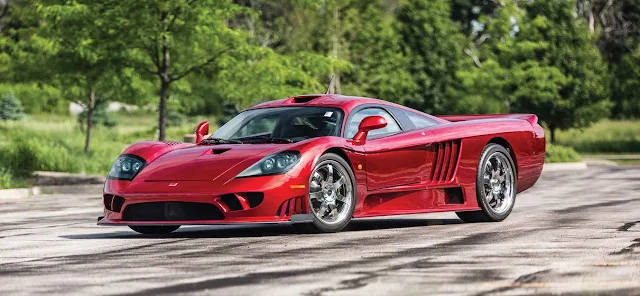Saleen S7 Twin Turbo
 |
| image is taken from roadandtrack.com |
Saleen S7: OVERVIEW
The S7 was the only street-legal vehicle in the US with more than 500 hp and 500 lb-ft of torque when it first went on sale in 2002. The S7 has received positive press from both the media and S7 owners, and various automotive magazines have named it the world's fastest American vehicle.
But over the past three years, the performance of cars has exploded, with models from brands like Ferrari, Lamborghini, Mercedes-Benz, Porsche, and Chevrolet boasting power figures above the formerly magical 500 level. Saleen is not an organization willing to rest on yesterday’s 0-60 mph times or quarter-mile speeds. Therefore, "all hail the S7 Twin Turbo" for 2005.
This is the S7's first significant update since its launch, and it's a BIG one with 750 horsepower and 700 lb-ft of torque—numbers we expect the competition will chase for a very long time.
Changes in 2005
In the late 1990s, it was very clear to Saleen product strategists that horsepower and torque figures were rising, particularly among manufacturers of supercars. Power personalities who appeared extraordinary at the time could appear rather ordinary a few years afterward. Therefore, Saleen engineers have been preparing for this moment ever since they sketched the first line for the original S7's 7-liter engine on a computer screen.
For 2005, aerodynamics has also been under review. You probably won't notice that the 2005 version of the S7 Twin Turbo has a revised diffuser/rear spoiler package and modified front fenders to enhance the S7's already sleek, swoopy, and aerodynamic lines unless you put the new model next to one of the original 2002 vehicles. The reworked front and rear diffusers, together with the new rear spoiler, resulted in a 40% reduction in aero drag and a 60% boost in downforce for the 2005 S7 Twin Turbo.
The S7 chassis has also undergone a considerable degree of modification to go along with the Twin Turbo's improved straight-line performance envelope. The suspension geometry has been altered to reduce squat and dip during acceleration and braking, and nearly every suspension pickup point has been revised.
The reworked pedal box in the S7 Twin Turbo enhances driving ergonomics and comfort. For easier pedaling, the clutch and throttle lever ratio pedals have been modified. The three pedals have also been separated from one another further without affecting the dead pedal.
Engine And Powertrain
The new seven-liter V8 engine casting was designed and tooled by Saleen to be made entirely of aluminum. Stainless steel valves, titanium retainers, beryllium exhaust valve seats, an aluminum throttle body, aluminum CNC-machined cylinder heads, and a stainless steel exhaust system are just a few of the space-age materials and engineering used throughout. The V8 features a special side-mounted water pump that was created by Saleen, a belt-driven camshaft drive, and a dry sump oil distribution system that was also created by Saleen.
The location of the engine in the middle of the chassis optimizes weight distribution and allows for an extremely tall engine with a highly effective induction system. A carbon fiber plenum receives air from an intake on the roof, which it then feeds through a 90-mm mass air meter. From the plenum, the air is directed to the two ball-bearing turbos, where it is pressurized to a maximum of 5.5 psi before entering an aluminum intake manifold with eight distinct runners through an oval-bore throttle body.
The fuel injection system for this setup consists of high-capacity, return-less, 52 lb/hr fuel injectors, and dual electric fuel pumps. Two twin-ball-bearing, water-cooled Saleen-Garrett turbos with 44-mm wastegates have been expertly built and fitted into the S7's dual, high-flow exhaust system made of stainless steel. Each bank of cylinders has four exhaust pipes that combine into a high-efficiency collector that resembles a racecar. Additionally, the exhaust features those twin wastegates discussed before, EGR, and two catalysts per cylinder bank.
And because Saleen values both power and clean air, the emission control system includes four catalysts, a high-volume evaporative emission system, and two heated, dual oxygen sensors for each bank of cylinders. Oh, and the system complies with OBD-II standards for safety and pure air.
A switch from hydraulic to solid lifters is one of the twin-turbo engine's few internal modifications. The engine may now rev harder and higher thanks to this adjustment. Additionally, the compression ratio has been decreased, as is customary for turbocharged engines.
It decreases from the previous naturally aspirated V8's extremely high 12.0:1 to a still-high 11.0:1. Saleen engineers also included oil squirters to cool the undersides of the pistons for better durability. Power is sent to the wheels through a modern six-speed transaxle with a special Saleen bell housing. The 8.0-inch, twin-plate, organic/metallic clutch has hydraulic actuation.



No comments:
Post a Comment